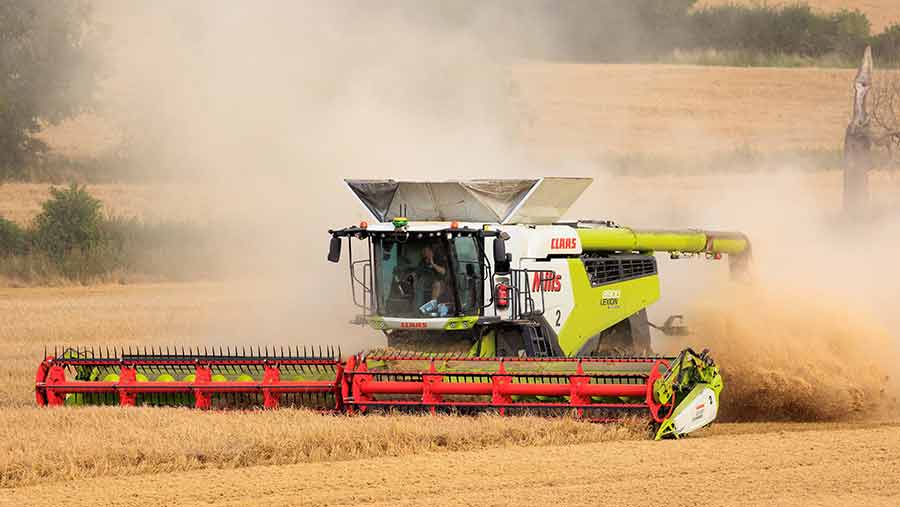Harvest 2023: Heatwave brings down moisture levels
 © Tim Scrivener
© Tim Scrivener Harvest 2023 is coming to an end throughout the country as spring barley is cut in the North, with this week’s heatwave keeping moisture contents below the drying threshold.
Morayshire
This week’s high temperatures, in the mid-20Cs, have been good for crops, says Frank Thomson, near Clochan. “Harvest has been good – it was a dry June and a very wet July, so I thought it would be bad,” he says.
First to meet the combine was 70.4ha of winter oilseed rape, which came off at 45-46% oil content, and yielded 4t/ha.
See also: Harvest 2023: The 5 top-yielding spring barley varieties map
Then 91ha of Skyscraper winter wheat yielded more than 9.9t/ha, followed by 364ha of spring malting barley, which averaged 6.6t/ha. Frank still has 40.5ha left to cut, and the moisture content when cutting yesterday (6 September) was 13%.
Although there’s still quite a lot left to cut in Aberdeenshire, Frank and his neighbours are near to completion.
Fife
Moving further south to Leckerstone Farm, near Dunfermline, John Hutcheson is halfway through his 202ha of Laureate spring barley, which is meeting malting quality and yielding 7.4t/ha.
“Spring barley has been late to mature; it had two-tier germination in spring,” says John.
He has also cut 48ha of Conway winter oats, a spring variety sown in the autumn. On contract to Quakers, it yielded more than 7.4t/ha. The 44ha of Conway oats sown in the spring is yet to be cut, but looks good in the field.
“Yields for winter wheat and oilseed rape were better than last year,” says John. His 275ha of Saki, Dawsum and Insitor winter wheat averaged 9.5t/ha, and will go for distilling, milling and some for feed.
His oilseed rape averaged 4.3t/ha. “Historically we have experienced pigeon problems, but we are controlling them now by scaring them on the quad bike, and using bangers,” says John, emphasising that it is a full-time job for three months.
Most neighbours are nearly finished harvest, with just spring barley left. “The heatwave has helped ripen the crops.”
Durham
In north-east England, Michael Manners has finished cutting combinable crops at Conicliffe Grange, near Staindrop, and is moving on to potato lifting.
Harvest 2023 started with 69ha of Funky winter feed barley, which yielded an average of 8.6t/ha, at 65kg/hl specific weight. “It was leaner than normal,” says Michael.
Next came 303ha of Dawsum, Astronomer and Typhoon feed wheat, which averaged 10t/ha and 77-78kg/hl specific weight. “For the year, I’m pleased. The moisture content was 20% when we started, then 15%, so averaged 17%.”
Lastly, he cut 80.9ha of Tundra and Vespa winter beans, which yielded 4.9t/ha. “Vespa blew over and was disappointing,” says Michael. “But the beans were cleaner than they have ever been before.”
County Down
Across in Northern Ireland, Graham Furey has nearly concluded harvest at Castleview, near Killyleagh, with 16ha of Vertigo spring beans left to combine at the end of the month.
The 32ha of winter barley averageed 7.5-8t/ha, with the six-row variety Tardis performing best. “Thunderbolt shed a lot of seeds,” says Graham. The specific weight was in the high 60s.
Next, ExStar oilseed rape yielded 4t/ha, followed by 16ha of Extase, Graham and Zyatt winter wheat, which struggled to hit 7.4t/ha.
“It was sown in February; if you hold off [until sowing conditions are better] you can get a good yield,” says Graham. “But it was a bad septoria year; Graham was under control and Extase was robust against it,” he says. “Specific weights have been okay and should be 72-78kg/hl.”
Neighbouring farms have started cutting spring barley at about 16% moisture content, which is doing better than expected, but anecdotally not weighing well.

